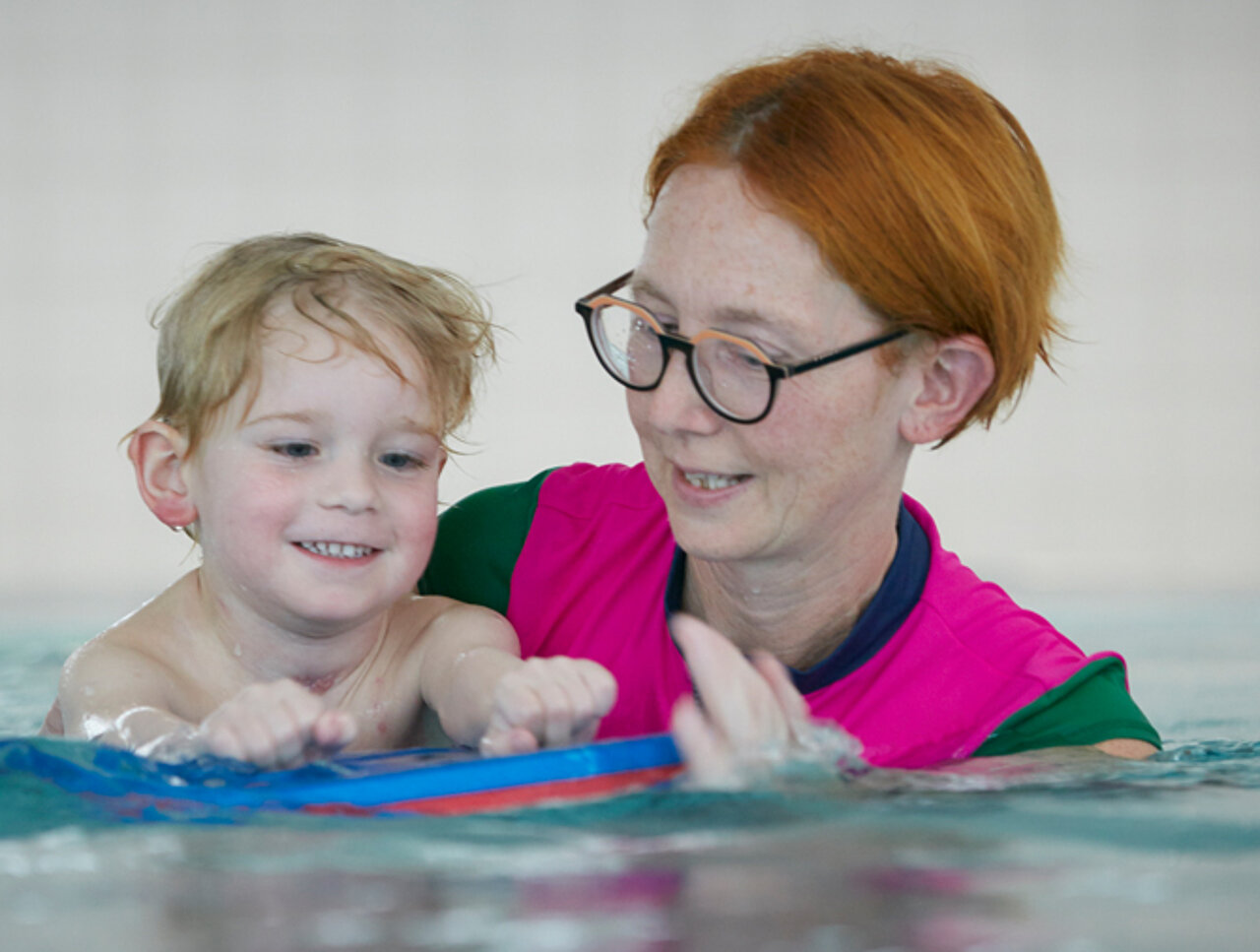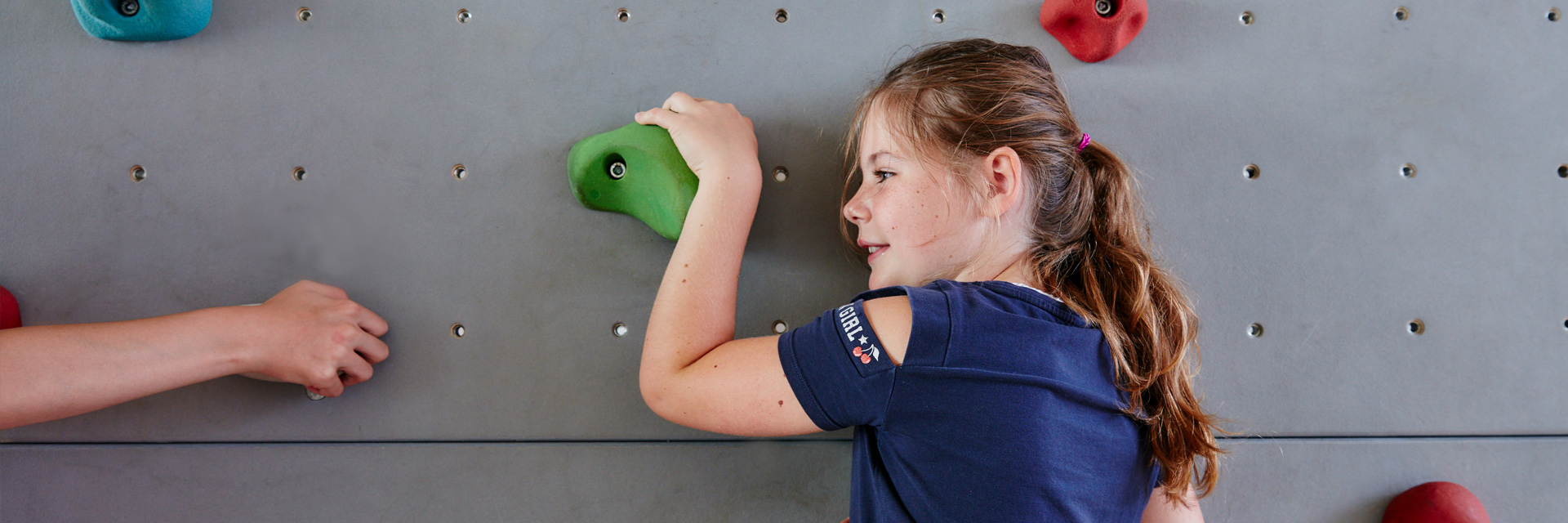
Physiotherapy
Reducing motor problems to expand participation
In physiotherapy, we treat in a goal-oriented way, individually adapted to the patients` needs and abilities and taking their environment into account. We are guided by the current Bobath concept, the ICF (international classification of functional ability of the WHO) and the current evidence base in neuro-paediatric physiotherapy.
In addition to a precise diagnosis, we offer a therapy that is oriented towards the needs of the patients and their social and material environment. Parents and caregivers as well as care institutions are involved in therapy decisions. We also try to achieve positive effects for the children's everyday life beyond their stay in the clinic through parent counselling and the provision of aids.

Identification of motor problems
An exact diagnostic assessment is the basis for all our therapy decisions.
In order to be able to understand the motor problems of the patients in their everyday life, it is necessary for us to take a close look at the activities in which the problems occur in the sense of a functional analysis. In this way, we can determine which areas of the body are causing the problem and which sub-functions are impaired as a result.
In developmental diagnostics, observation of the child and its environment plays a major role, especially with younger children. With older children and adolescents, neurological, orthopaedic and sensorimotor aspects are increasingly added. We use scales, tests and assessments for meaningful documentation.
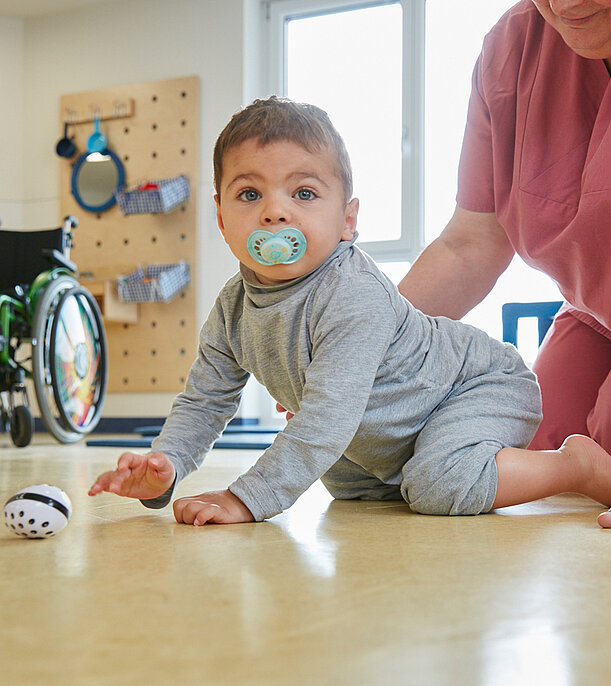
The basis for optimal support of infants and toddlers is the determination of their developmental status.
As a basis for therapy planning, we also analyse any existing problems and, if necessary, their causes and correlations. When setting goals and selecting interventions, we are guided by the boundary stone concept and the environmental conditions.
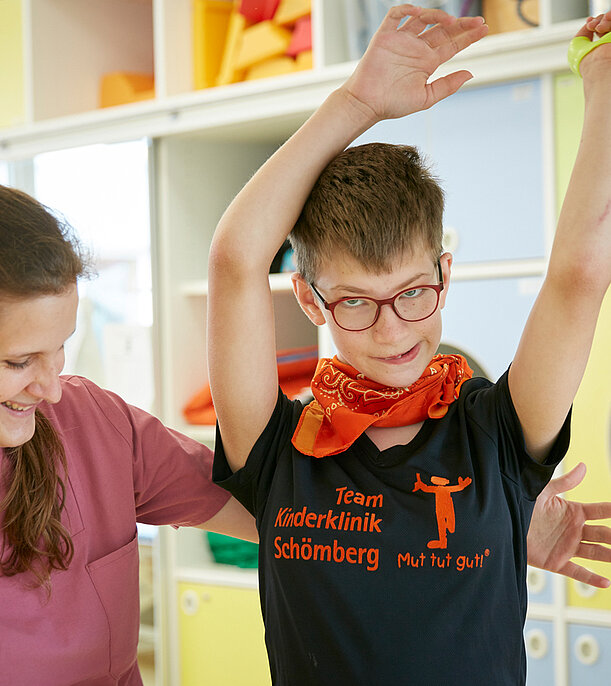
For older children, we record findings according to the severity of the motor impairment, which, starting from participation, records the abilities and analyses the problems in activities for their possible causes in the area of body structures and functions (based on the ICF-CY). Adapted assessments are used for the progress documentation.
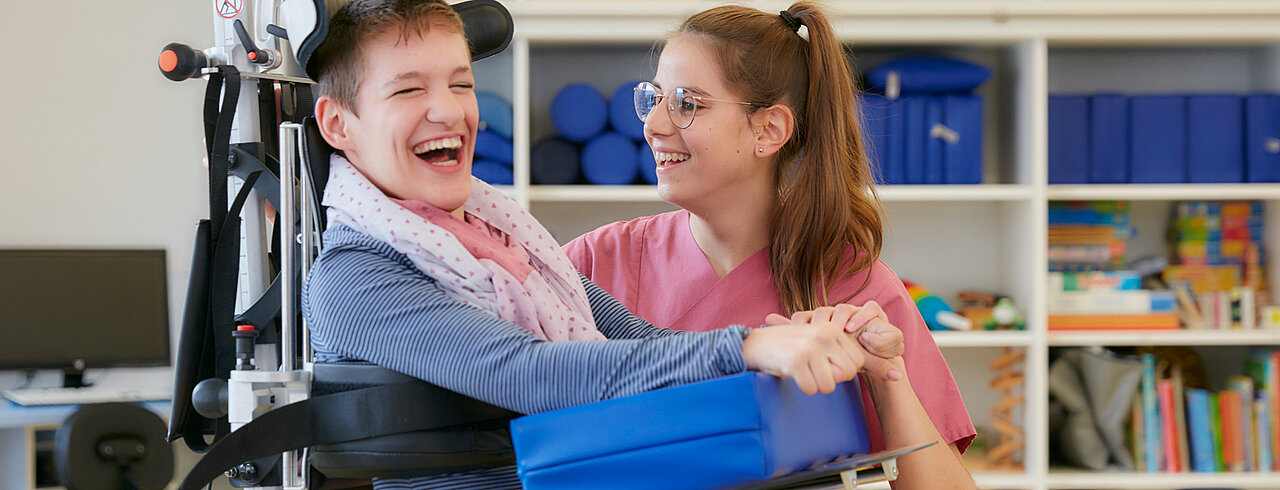
Expand motor possibilities
Physiotherapy on a neurophysiological basis has been a standard in the treatment of people who have movement disorders with neurological causes for many years.
The treatment methods are individually adapted to the respective situation and include the caregivers, the current and home environment as well as possible aids.
We use the Bobath concept and the Vojta method as well as other approaches or combined treatments. The decision is made according to the current evidence, also based on objectives and the prospects of success in the individual case. This applies both to the area of developmental support for smaller children and to neurorehabilitation for children, adolescents and young adults.

In promoting motor skills, we build on existing abilities and focus on the demands of everyday life.
As a result of an orientation towards non-linear developmental concepts, we work with early verticalisation oriented towards the border stones, especially with younger, severely affected patients. Through counselling of and cooperation with parents/caregivers, we try to incorporate treatment focal points into everyday life.
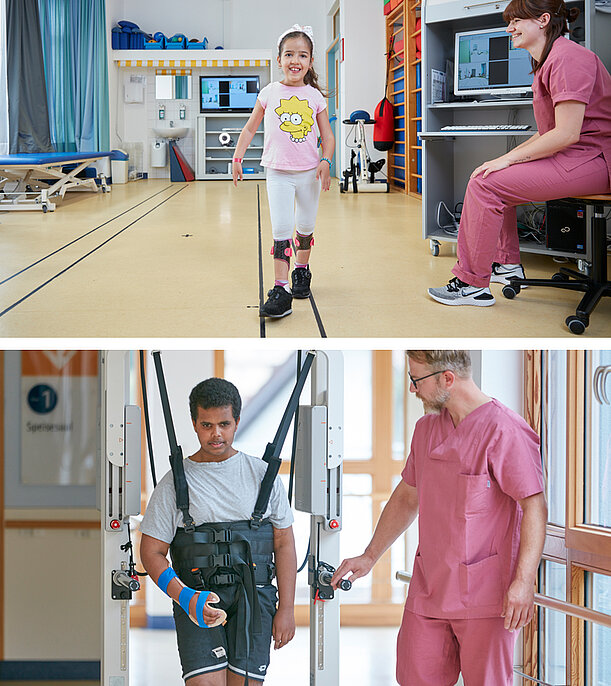
Gait analysis
We use video-assisted (SIMI) and observational ("understanding walking") gait analysis to determine the special features of our patients' gait pattern. Together with the orthopaedic and neurological findings, we analyse the abnormalities for possible causes and the causative structures. This analysis is used to determine individual therapy options as well as to evaluate function-supporting aids.
Gait therapy
We use a variety of approaches to treat gait problems:
- Gait training in the Innowalk
- Training on the treadmill, with or without weight relief
- Training with various mobility aids
- Functional and self-determined training with the Andago; this can also be used to train on flat surfaces with weight relief
- Targeted treatment of structures and functions that cause problems when walking
- Training with and fitting of orthoses and walking aids

In order to provide more security in various positions, to facilitate breathing, to maintain or develop mobility and to prevent the development or worsening of contractures, patients are positioned in therapy and/or in everyday life and regularly repositioned. This is done in cooperation with the staff on the wards or the caregivers.
For patients with increased secretion or strong mucus production, we offer the testing of abdominal positioning modules. These help to remove secretions. Especially in early rehabilitation, this can be done with individual positioning modules (according to the Bobath concept) or with blankets and pillows (according to the LIN concept by H. Pickenbrock) and has a calming and tonus-reducing effect. Children with restlessness can also benefit from this to some extent.
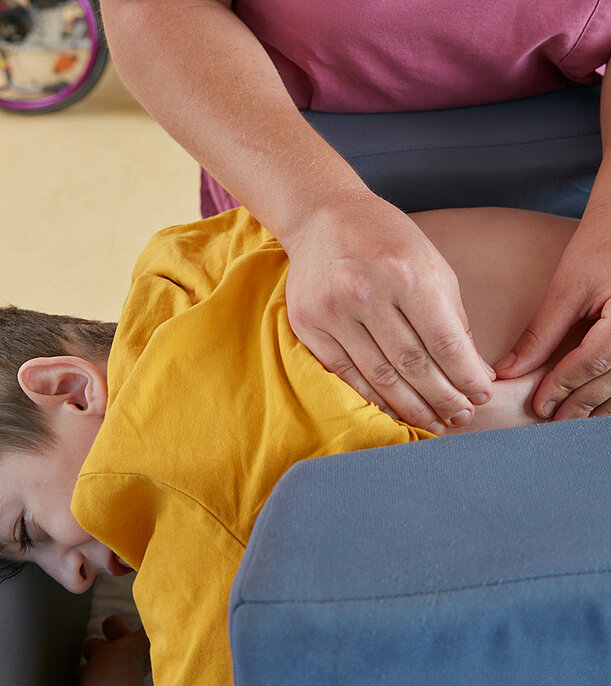
Especially patients with acquired brain damage often have problems keeping their airways free of secretions.
But other problems with breathing can also occur in neurologically affected persons. As a supplement to medical and nursing treatment, we offer breathng therapy by our physiotherapists if required. Depending on the individual possibilities and problems, manual techniques and positioning treatment are used to try to loosen the secretions, to facilitate transport to the oral cavity or to the tracheostoma, and to help the children get rid of the secretions by coughing support or drainage support. Our aim is to get patients to the point where they can learn to manage their breathing and secretion elimination themselves or with as little help as possible.
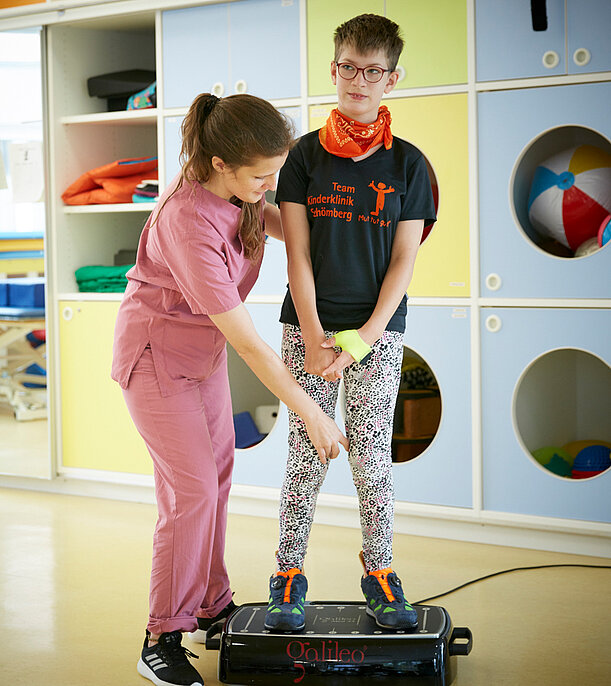
Strengthening the muscles is also an important part of therapy for children with neurological problems.
Often it is the erector muscles that are too weak to allow effective postural control. Here, in addition to manual techniques, vibration plates (Galileo) are used to strengthen muscles and build a reliable postural base. However, vibration plates can also be used with other frequencies to regulate tone. A Galileo plate with a tilting table is also used in the Children's Hospital Schömberg as preparation for or as part of the therapy. People who cannot stand freely, for example, benefit from this.
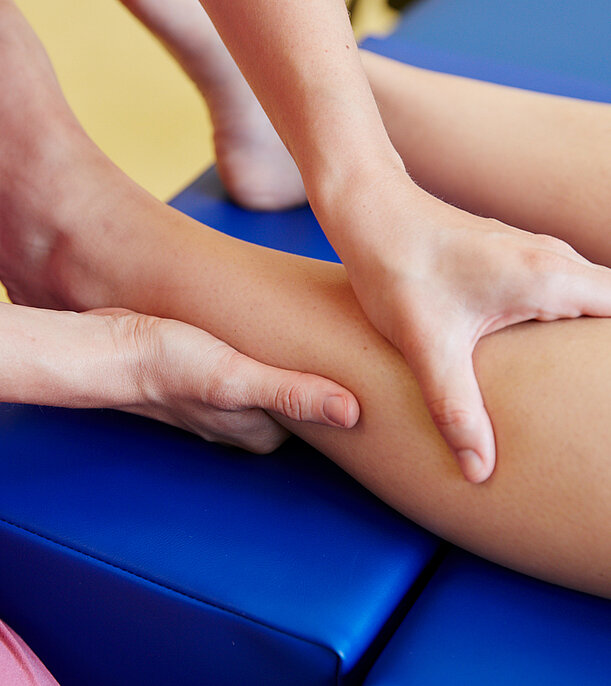
Scar treatment
Orthopaedic operations often result in scars. If these are not treated, they can harden and restrict mobility. Especially for patients whose mobility is already limited by other factors, scar treatment is a way to avoid additional problems. We work with a combination of manual and physical techniques. In addition to special massage techniques, heat, cold and other ways of stimulating the local metabolism are used.
Lymphatic drainage
Immediately after operations, there is often swelling and accumulation of fluid in the tissue. We help here with lymph drainage and other decongestive techniques, thus creating the conditions for freedom from pain and movement. In addition to manual techniques and compression, tape systems are also used.

Gaining experience of their own movement and action possibilities through play is very important for the development of children of kindergarten age.
Challenges to motor skills and posture control lead to their improvement quite incidentally. This is further enhanced by the shared experience in the psychomotor group.
It is often difficult for children, adolescents and young adults with disabilities to gather sensory impressions themselves. In groups, sensory perceptions are stimulated with basal offers and the confrontation with them is used for learning steps.
We also use the Feldenkrais method to train self-awareness: learning to perceive something in one's own body through the smallest movements is the prerequisite for changing oneself and one's movements. Feldenkrais work is also used to train self-awareness.
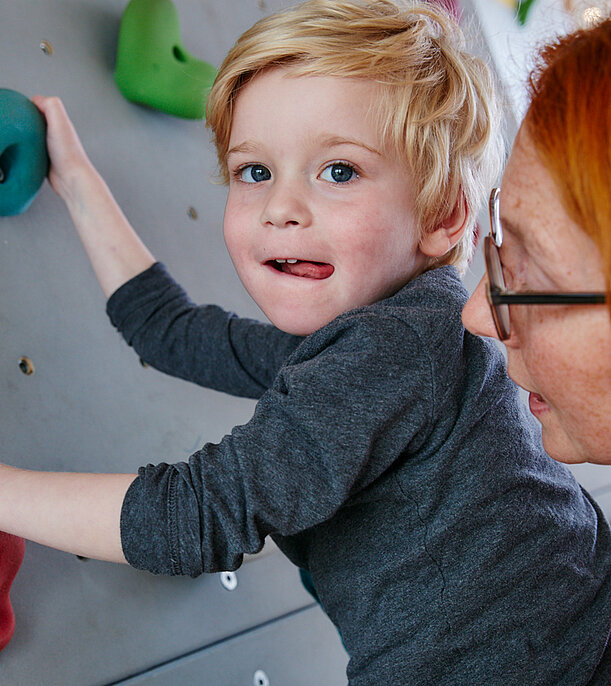
Climbing on the bouldering wall (room height) is a nice way to provide challenging movement experiences for Children with movement disorders under supervision and with assistance.
It is less about great heights or degrees of difficulty than about having fun with the challenge and proving oneself on the straight or inclined bouldering wall. The inclinability of the wall makes this experience accessible to children who would not be able to climb on a vertical wall. This therapy takes place in a group and thus offers the additional opportunity to try out rule-governed togetherness, to have fun together and to let the presence of observers motivate them to achieve their best.

Counselling enables transfer of achievements into everyday life
Physiotherapy has a much more lasting effect if elements of it can be integrated into the children's everyday life.
We therefore offer various possibilities to plan, try out and possibly adapt aids. But also the transfer of positioning, positioning and transfer possibilities into the post-clinical everyday life plays an important role. To enable these transitions, the involvement of caregivers in the therapeutic process is particularly important to us."
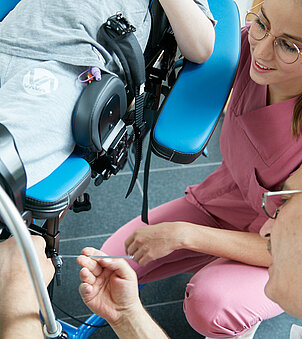
Both in the context of developmental support and in a rehabilitative setting, assistive devices are often needed to achieve certain functional goals or to make participation in everyday life possible.
Advice on aids, testing and optimisation therefore play a major role in our physiotherapeutic work. This applies equally to commercial products or small aids and tips for everyday life.
In the context of learning to walk or gait rehabilitation, orthoses are often used to give the feet a stable base and to ensure mobility of the ankle joints. Selection, fitting and testing take place in cooperation between the family, orthopaedic technician and physiotherapy staff. Standing aids and trunk orthoses help to maintain an upright position. For the locomotion of patients who are unable to walk, the individual selection and fitting of walking aids, wheelchairs and seat shells in cooperation with rehabilitation technicians close to home is important for mobility and participation in daily life.
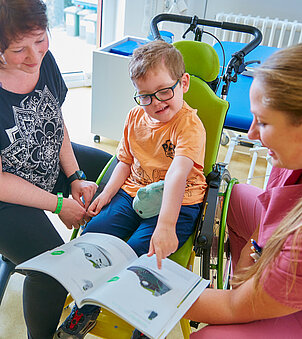
Regardless of whether it is a question of handling, transfer or aids, it is important that the parents or other caregivers understand what is beneficial or harmful for their child. Therefore, parents or caregivers are included in the therapeutic process if they wish.
Questions of positioning and shaping the environment become vivid for the parents and thus transferable to everyday life. The progress in the therapy also becomes visible for the caregivers.
For parents who cannot be present the whole time, we offer counselling sessions in between or at the end of the stay. Topics include handling and carrying smaller children, carrying or transferring larger children or young people with disabilities. In addition, we consider together how the skills acquired in therapy can be transferred to everyday life and how the best possible participation in everyday life can be achieved with the prescribed aids.

Therapeutic riding
The aim of therapeutic riding is to find one's own centre on the swaying back of the horse, to remain balanced, but also to experience one's strengths and weaknesses in dealing with the animals.
In the process, as in hippotherapy, work is done on the prerequisites for walking. The three-dimensional movements of a horse at a walk train posture control and adaptability, which are also needed for walking. In addition, therapeutic riding is also open to non-walkers. They benefit for their posture while sitting and their locomotion in a wheelchair. This offer is made possible through the kind support of donors and is carried out in cooperation with local professionals. Information on how to donate can be found here.

Water therapy
Water therapy in warm water has a relaxing and tonus-reducing effect.
This releases reserves of movement, which can be implemented better in water than on land due to the reduced force of gravity. In water we have very good conditions for active or passive mobilisation of the torso and extremities. Due to the buoyancy on the one hand and the resistance of the water on the other, water therapy can also be used excellently in gait rehabilitation. Individual and group movement in water is often easier than on land.
We follow the McMillan method (Halliwick method) when learning how to move around in water. In a step-by-step plan, we first work on breathing in the water, then on "letting the water carry you" and finally on locomotion (swimming).


